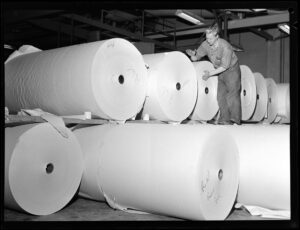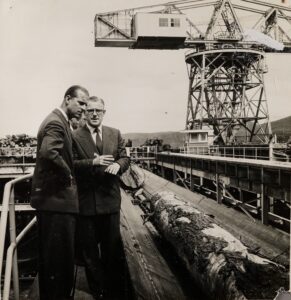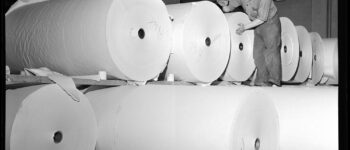1953: Kawerau
June 10, 2021
By AHNZ
 Geothermal power and a sea of exotic forest were just raw ingredients but it was the great industrialist Sir James Fletcher who figured out how to cook up a town out of them, Kawerau. Milling timber is this towns reason for being and, at one time the biggest pulp and paper mill in the Southern Hemisphere. Since 1953 it has slowly been eating up the Kaingaroa State Forest and adding value to what was otherwise a dubious asset.
Geothermal power and a sea of exotic forest were just raw ingredients but it was the great industrialist Sir James Fletcher who figured out how to cook up a town out of them, Kawerau. Milling timber is this towns reason for being and, at one time the biggest pulp and paper mill in the Southern Hemisphere. Since 1953 it has slowly been eating up the Kaingaroa State Forest and adding value to what was otherwise a dubious asset.
The Government created Kaingaroa State Forrest with not particular idea in mind other than giving convicts and the unemployed something to do in the 1920s and 1930s. They created more trees than even they intended to, and with no use! Good enough for government work! By the 1950s the trees were elderly, soon to be devoured by borer or blown over in the wind, another monument to Statist New Zealand stupidity. Then, James Fletcher, capatalist (or crapatalist, ie state-entreprener, depending on your point of view) urged the ‘owner’ government (National 1.0) to solicit tenders for somebody to do something to process this exotic timber. Couldn’t somebody think of something to do with it, though was experimental and untried?
Someone did. In 1952, the Tasman Pulp and Paper Company was created as a syndicate of central government, Fletcher’s company, and foreign investors. It turned out that the government didn’t know what it was doing but the free market could bail it out, once again.
The Kawerau Affair

Kawerau became one of New Zealand’s youngest and most thoughtfully designed towns. The houses were built along 1950s designs similar to government state houses but they weren’t. The similarity was that Fletchers were the builders of both. However, Kawerau was a success quite unlike government projects such as Wellington’s Porirua (1940s) or Auckland’s Otara (1952) which became slums.
Kawerau became a place for young men to earn their fortunes and even came to out-strip other towns when it came to consuming things like music and cigarettes and electronics. This customer base combined with the expertise of young professionals created enough interest to create a group who demanded something as yet unseen in New Zealand: television.
“There were so many single men working in Kawerau with plenty of wages and not much to spend them on.” At one time the store was the biggest stand-alone seller of cigarettes in the country and was the sixth-largest outlet for gramophone records. Not bad for a town the size of Kawerau.”” – Plenty
“The New Zealander, having had quite enough of Robbin Nash and Frier Nordy started building television infrastructure themselves. Free, private people, formed their own societies to do so. They bought, constructed, and installed re-transmitting stations throughout the country without Government help and often in defiance of it.” – 1962: Television Anarchy, AHNZ
“In November 1962, the Minister of Broadcasting ordered the translators confiscated and a deadline was issued. Bryce of Kawerau and his fellow Ayn Rand heroes ascended the Manawahe Hills to receive the Television Mafia….who never showed up. The Government had lost the fight, it backed down.” – ibid
Everything the State does tends to achieve the opposite of the intended results, as a rule. Busy work to keep prisoners and the unemployed under the thumb ended up creating a great uprising against the New Zealand government. It was one they did not win. Pirate TV broke the government embargo, letting a genie out of the bottle that our government had managed to suppress long past due. This revolution was fought and won in by Kawerau heroes who set an example for the rest of the country to follow.
Demise
As correctly predicted by Kenneth Cumberland in his George Andrews documentary, Landmarks, Kawerau’s raison d’etre is processing cellulose. Unfortunately, news headlines say that time is now up.
Everything “..and everybody in Kawerau depends on that mill. Like all other special-purpose town its existence rests on a single industrial foundation. If that industry fails the whole town comes ‘a cropper.” – Cumberland
“Norske Skog’s Tasman pulp and paper mill at Kawerau has confirmed it will close. The Norwegian-based company said it will sell the mill’s assets and stop production by June 30.”- Kawerau’s Tasman mill confirms closure, Stuff news (June 2020)
Ever since watching Landmarks, I’ve wanted to pay a visit to Kawerau to see it for myself. Now it’s become more urgent, including paying a visit to the Sir James Fletcher Kawerau Museum. Unless we can find another, modern day, Fletcher to save Kawerau from the fire then it’s going to itself be turned into pulp.
—
Image ref. newsprint paper from Tasman Pulp and Paper Mill, Auckland Libraries Heritage Collections
Image ref. Prince Philip visits the Tasman mill in December 1956; Sir James Fletcher Kawerau Museum; Kawerau Library and Museum, Facebook
Ref. p40, Plenty (2, 2016)
 Like Comment Share
Like Comment Share





